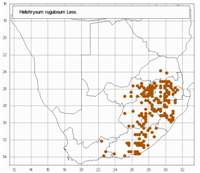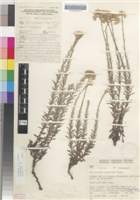Common names:
marotole, motoantoanyane, pulumo-tseou (SS), Imphepho (Sw)
Origin of name:
rugulosum = wrinkled
Diagnostic characters:
Stems mostly simple and erectCream coloured bractsCompact flower heads / inflorescences
Description:
Perennial herb, rootstock creeping, branching, flowering stems tufted, simple or branching near the base, erect to c. 300 mm, thinly white-felted, closely leafy. Leaves sessile, up to 25 x 5 mm, rarely a little larger, often only c. 15 x 2-3 mm, diminishing upwards, somewhat spreading or ascending, lower oblong-lanceolate, acute, upper lanceolate, acuminate, sometimes very narrow, margins subrevolute, upper surface thinly cobwebby-felted, rugose, lower white-felted, the hairs often stringy. Heads heterogamous, campanulate, c. 5 x 4 mm, few to many in compact corymbose panicles. Involucral bracts in c. 4-5 series, graded, inner about equaling flowers, loosely imbricate, tips opaque, crisped-dentate, often purplish or pink initially, later creamy, or the inner creamy, or all creamy, minutely radiating. Receptacle with fimbrils exceeding ovaries. Flowers 17-42, 8-19 female, 9-30 homogamous, female flowers sometimes equaling or slightly outnumbering homogamous. Achenes 0.75-1 mm long, broadly cylindric, with myxogenic duplex hairs. Pappus bristles many, about equaling corolla, scabridulous, bases cohering by patent cilia.
Flowers mainly between December and March.
Distribution:
Grows in poor stony or sandy grassland, and readily invades overgrazed areas and roadsides. Ranges from the Limpopo, Gauteng and Mpumalanga Highveld and eastern highlands through western Swaziland, the eastern half of the Free State, the Midlands and Uplands of KwaZulu-Natal, Transkei and E. Cape to the southern Cape as far west as the Swartberg, and Aasvogelkop in Riversdale district.
Grassland, Savanna, Thicket, Nama Karoo and Fynbos Biomes.
Notes:
The well crisped, denticulate, somewhat squarrose involucral bracts and long fimbrils on the receptacle, together with generally simple stems without axillary leaf tufts, characterize the species. Specimens from Katberg and the Amatola Mountains (e.g. Galpin 2398, PRE), often have numerous short branches arising near the base of the flowering stems and very narrow acuminate leaves, but do not differ otherwise.
Capitula generally larger than those of H. rosum and H. athrixiifolium.
Taxonomy:
Literature:
Helichrysum rugulosum Less., Syn. Comp. 307 (1832); DC., Prodr. 6: 205 (1838); Harv. in F.C. 3: 250 (1865); Moeser in Bot. Jb. 44: 282 (1910); Hilliard, Compositae in Natal 198 (1977).
Type:
Lectotype: Cape, Plettenberg Bay, Mundt & Maire s.n. (G!).
Synonym(s):
H. rugulosum var. angustifolium DC., Prodr. 6: 205 (1838). Lectotype: Cape, Colesberg div., Naauwpoort, Burchell 2764 (G-DC, not 276A as transcribed by DC.).
H. rugulosum var. latifolium DC., 1. c. Lectotype: Cape, Albany, Dr�ge 5782 (G-DC).
Gnaphalium rugulosum (Less.) Sch. Bip. in Bot. Ztg 3: 172 (1845).
Vouchers:
Acocks 9245 (PRE); Bolus 419 (BM; BOL); Flanagan 264 (NBG); Hilliard & Burtt 6646 (E; K; MO; NU; PRE); Story 1470 (PRE).

